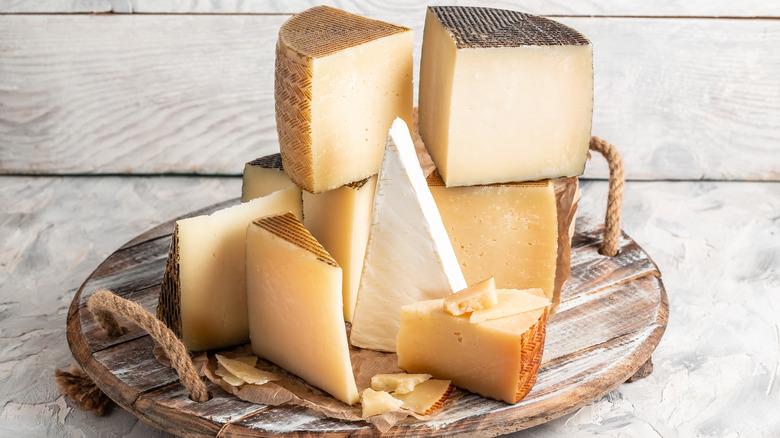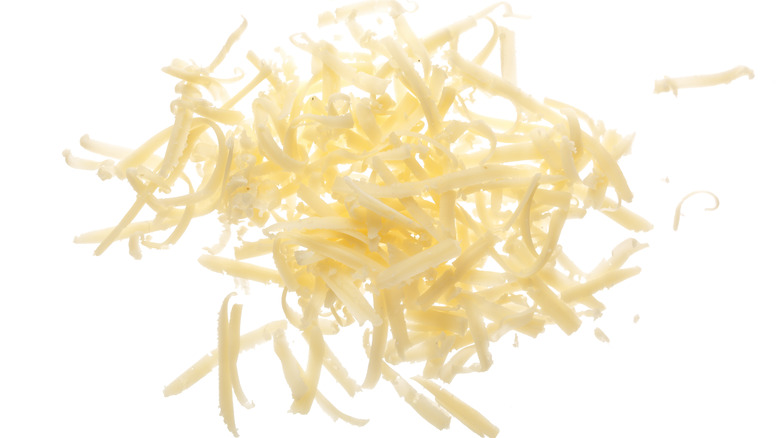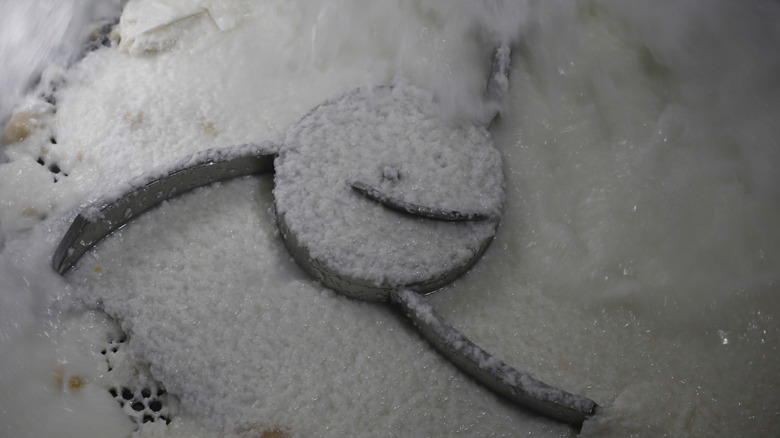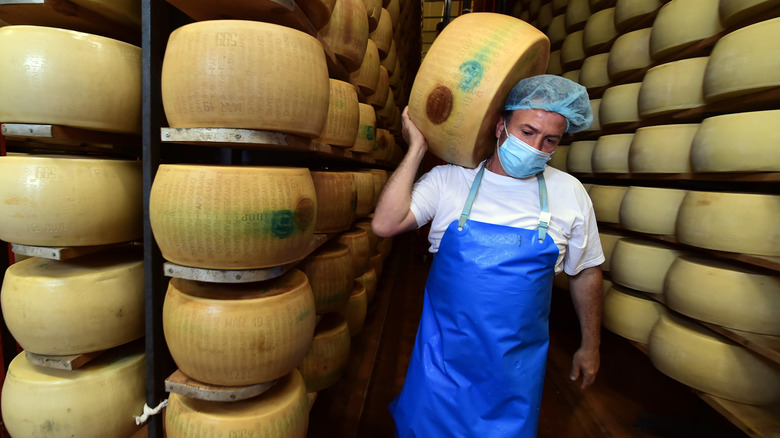What Is Cellulose And Why Is It In Cheese?
If you've eaten shredded cheese or ice cream, you've almost certainly eaten cellulose. And despite the occasional uproar it causes in worried consumers, in small quantities, it's perfectly safe to eat. "Basically anything with plant stuff in it," is how Jeff Potter, author of Cooking for Geeks, explained cellulose to Bon Appétit. The panicked confusion that bubbles to the internet's surface every other year or so is due to a conflation between the fact that you can derive cellulose from sawdust and the sawdust itself. Yes, since cellulose comes from plant matter, many companies source it from sawdust. However, the same substance can come from apples, corn husks, or whatever else.
Basically, by the time it's cellulose, it's, well, cellulose — a tasteless powdery substance like sawdust. The purpose of mixing cellulose into your foods, though, is not to affect the flavor, but other properties of the product, like its texture. The positive reason for cellulose's inclusion in your shredded cheese is its anti-caking and moisture-absorbing properties. Without cellulose, your shredded parmesan cheese would stick together as a clumpy dairy blob.
The history of the use of cellulose
Other uses for celluloses, Marketplace writes, is to add additional fluff to bread, make ice cream feel creamier without having to resort to introducing more cream, and to sell foods with cellulose as containing "dietary fiber," though cellulose doesn't actually deliver any of the nutritional content we associate with the word "fiber."
But even though apparently pointless food additives carry a contemporary ring, the use of cellulose as a cheap substitute goes back a couple of hundred years. Marketplace describes how wheat was scarce in 18th-century Britain, but mills were relatively common. "We're selling stuff by weight and people don't really have a good way of knowing what's flour and what's sawdust," Penn State food historian Bryan McDonald tells Marketplace, laying out the logic of the millers.
Ultimately, it is about producing more foods at a lower cost so that they can fill shelves with the number and cheapness we expect of such goods.
Misconceptions and restrictions surrounding cellulose
In February 2016, Universal Cheese and Drying and International Packing, two companies that sold packages of pre-shredded cheese, pleaded guilty to charges of adulterating and mislabeling their romano and parmesan products. The summary kept by the United States Department of Justice noted that each company accepted its fine of $500,000. In a separate press release, the department also announced that Michelle Myrter, the executive most implicated, had to pay $1,000, complete 200 hours of community service, and be listed on probation for the next three years.
For those who passed through 2016 in blissful unawareness of the great freakout, the issue with the cheese sold by these companies is that they contained wood pulp. Or so the social media hype exclaimed. In actuality, as HuffPost reported at the time, the shredded cheese contained cellulose. But since the FDA is fine with the presence of cellulose in small quantities, the charges boiled down to something else entirely. The reason those cheese companies in particular faced penalization was that their parmesan contained no parmesan, but the bits of other cheeses and cellulose. More importantly, it contained such a degree of cellulose to fill out the product that even deeming the shredded cheese as cheese was a suspect move.
Cellulose vs. starch
The closest comparison to cellulose that one can make is starch. All Difference Between explains that as individual molecular units, the two are very similar. However, as they extend into a longer chain of those units, they differ. Cellulose develops more fibrous characteristics and a stronger molecular chain while starch remains a grain and is weaker. These differences also lead to the fact that starch dissolves in water while cellulose does not, which informs why we use it to cake shredded cheese and other food products we want unmoistened.
In terms of nutrition, Your Health Remedy offers the difference about how easily we can break down the two chains. We digest starch easily, but not cellulose, which goes back to how cellulose is formed from a stronger chain. This is despite the fact that the glucose of which cellulose is composed is the same as that upon which we regularly run.
Ways to substitute cellulose
Perhaps you are now disgusted with the practices behind these pseudo-parmesan peddlers and want to punish them with your wallet. Where should you push your dollar bills?
TODAY received some tips on how to buy unadulterated parmesan from Liz Thorpe, author of The Cheese Chronicles. You can buy authentic, Italian parmesan with the words "Parmigiano-Reggiano" emblazoned along the rind. Or, if you're still buying American, you can purchase a wedge of cheese instead of the pre-shredded variety. However, some artisanal brands may offer shredded parmesan without the cellulose and some cheese stores will happily grate the cheese for you. You should keep in mind though that these cheeses will not last as long as the cellulose-infused ones.
For those who can afford it, these tips may serve as sensible guidelines. As Delish reported during the wood pulp furor, Universal Cheese and Drying and International Packing are not the only culprits of counterfeit cheese. All "processed cheese," "cheese food," or "prepared cheese" fall into this category with most boasting a cellulose content as well. This makes up most cheap cheese and so, most of our diets.




